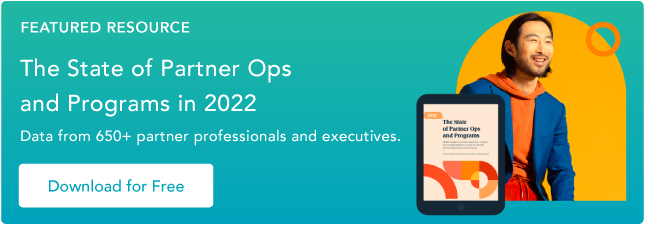Methods for Leveraging Your Business Ecosystem
1. Learn about the business ecosystem mindset.
2. Research your business ecosystem.
3. Build market awareness and generate leads.
5. Exchange referrals with your ecosystem.
7. Ask partners to influence your deals.
9. Increase retention and customer satisfaction.
10. Scale your ecosystem relationships.
Formal partner programs provide one of the more effective avenues for connecting you with other organizations in your ecosystem — but you don't necessarily need one to work with those kinds of companies and leverage that network effectively.
Your ecosystem is made up of all the related software, services, publications, agencies, and associations that your customer might interact with when buying or using your product.
You can work with these organizations to source high-quality leads, get support in the sales process, and ensure all of your customers are successful with your product or service.
1. Learn about the business ecosystem mindset.
Before you try to get help from your ecosystem, you need to understand how ecosystems work. Ecosystems are built on the concept of "1+1=3" — working with another organization in a way that benefits you both.
The focus of any ecosystem relationship is on adding value to the end customer by working with other relevant outlets — and sales teams tend to lose sight of that principle. They wind up asking for referrals or support from other organizations without offering anything in return.
While that kind of selfishness might occasionally land a deal or two, it's ultimately shortsighted. It can alienate the other organizations in your ecosystem — making you lose out on the larger benefits that come from fostering sustained relationships.
Productive ecosystems are based on reciprocity. No matter the duration of your relationship with another organization in your space, you have to do what you can to ensure that both parties see the partnership as beneficial.
For more perspective, read our report on the ecosystem business model to get an overview of how ecosystems are operating today.
2. Research your business ecosystem
Once you understand the underlying principles that make for a productive ecosystem, you need to survey your own. Make sure you understand the types of organizations your customers are relying on in their buyer's journey.
You can start by connecting with your company's partnerships team. Ask them what type of partners they are working with and what their ideal partner profiles are. The most common type of partners are technology partners, solution, agency, affiliate, and referral partners — but there are plenty of others, like VC or media partners.
Source as much information as you can from your partner team — then, take a closer look at your ideal customer profiles. Your organization’s customer profiles should also contain information on whom your customer turns to for advice and support.
Map out the different products, services, and information sources your customers rely on when buying and using your offerings. That will give you a high-level overview of your broader business ecosystem.
Once you have a solid picture of the elements that directly influence your customer, conduct extensive research to understand the goals of each of the organization types in your ecosystem. This insight will help you build mutually beneficial relationships.
It will also make your outreach more specific and effective. Reaching out to a potential partner in your business ecosystem should include a tailored message that explains how they would benefit from working with you — not entirely unlike how you would connect with prospects.
A business ecosystem map should also help you prioritize your time and energy. You need to have a sense of what organizations are worth the effort. Not all partnerships are created equally — and having a thorough, thoughtful business ecosystem map gives you a better sense of which ones offer the most value.
Identifying those potentially productive relationships starts with pinning down where you need help the most. For example, let's say you work at the director level of an edtech startup that has no problem closing but struggles with lead generation. If that were the case, you might want to connect with a publication that covers trends in higher education with the influence to direct university administrators to the top of your funnel.
By understanding your needs and then understanding how other organizations may help, you can figure out where to focus first.
3. Build market awareness and generate leads.
As I touched on in the previous point, if you need more quality leads and brand awareness, reaching out to publishers who provide content to your customer is a good place to start. Affiliate partners can drive awareness of your product and service in addition to sending qualified leads through marketing links.
Your marketing department might already have an affiliate program set up, but if they don’t, you can propose one.
When affiliate programs are well-run, they build positive brand equity and provide a steady source of quality leads. Affiliates are brand advocates — and in most cases, they're willing to share your product or service in exchange for commission.
But the best affiliates aren't just in it for the money — they also believe in what you're selling. They maintain trust and credibility with their audiences by only recommending high-quality products and services.
Vet potential affiliates for alignment with your brand and how they might represent your company. You don’t want affiliates spamming on your behalf, undermining your reputation — nor do you want your SDRs to have to sift through a bunch of low-quality leads.
4. Join relevant communities.
Communities and associations that your customers belong to can be invaluable components of a productive business ecosystem. For instance, groups like Pavilion, Partnership Leaders, Product Collective, and APIs You Won’t Hate are all communities that cater to different types of buyers.
You won’t be able to join all of these communities or associations — as some of them restrict membership to their specific personas. But even when you can’t be a member, you can follow their content, engage with their posts on social media, and attend their public events.
Participating in these communities is a great way to network with other organizations and stakeholders in your business ecosystem. Doing so can give you a deeper understanding of your prospect and offer opportunities for referrals and deal intel.
5. Exchange referrals with your ecosystem.
Referrals are direct intros to accounts. Most decision-makers conduct the majority of their buying process before speaking to an AE — which means you can lose out on a lot of deals if you don't have networks of trusted organizations out there referring prospects to your business.
Referrals from organizations in your ecosystem close more frequently than most other sources. To find referral partners, consider how organizations would benefit from sending you business — exchanging referrals is one of the more straightforward, effective ways to get there.
Make sure your products or services complement each other and that you can trust the other team to provide a good sales process and customer service. You don’t want to send customers or prospects to businesses that won't put them first.
Not all referral partners need to receive referrals back. You may be able to provide them value in some other way.
For example, a CRM company might be asked in their sales process about products that integrate with their CRM. If the AE can rely on a company that sells an integrated app to help answer questions during the sale and deliver an excellent product, then they might consider the situation a win-win — even without receiving referrals back.
In many cases, the easiest way to start referral relationships is to provide value to the other organization. This might be by sending reciprocal referrals to a company or supporting its sales efforts in some other way. If things go well from there, then you can foster a productive ongoing relationship.
Referrals can also be compensated with commission. If you have a strong ecosystem and you have been able to successfully get referrals from other organizations through networking, setting up a formal partner program to manage the referral process at scale is probably worth your time.
6. Use second-party data
New apps like Crossbeam, PartnerTap, and Reveal make it easy to share data with other organizations in your ecosystem. You can connect with potential partners on these platforms to share prospect and customer data.
These systems can help you determine whether you want to work more closely with an organization. You generally start by seeing how many shared customers you have — something you can do without sharing any customer names.
But the size of a shared customer overlap is only one factor that can dictate whether you want to work more closely with a potential partner. Once you decide to move forward, these data mapping tools integrate with your CRM and Slack — making it easy to see when a prospect of yours is a customer (or a partner) of your partner.
When you see a prospect is already a partner's customer, you can message the partner and ask for an introduction, reference, or intel on the account. If you and a partner are pursuing the same prospect, you can share information and contacts or consider co-selling together.
You can share more data to help refine your understanding of your prospects and customers when you work closely with partners. If you vet your partners properly, second-party data from your partners can be higher quality than third-party data and more scalable than first-party data. You can use these data insights to close prospects faster and better target your outbound messages.
7. Ask partners to influence your deals.
Organizations in your ecosystem can send referrals for new accounts and influence your active deals. When deals stall or look like they’ll be lost to a competitor, calling in a partner can often drag a deal over the finish line.
Partners in your ecosystem can help in a variety of ways. They can provide valuable intel on accounts. For example, they might know the most relevant stakeholders, when strategic planning occurs, what budgets are available, and details about an account’s product or strategic roadmaps.
This type of partner intel can help you to customize your approach and messaging to dovetail with exactly what a prospect account needs. As with referrals, sharing this type of information can be part of a partner program — or it can come out of relationships you develop.
Another key way partners can influence an account is by providing an intro to a decision-maker you aren’t already speaking to. Such introductions can change the course of your deal and speed up the time to close.
Partners can serve as a reference or trusted endorsement of your product. These can hold more weight than a typical customer reference if the partner has a close relationship with your prospect.
Partners can also provide demos, product enablement materials, and other more active assistance in a deal. This may be because they have a product that integrates with yours or because they provide a related service.
The best way to have organizations in your business ecosystem influence your deals is to foster close relationships with partners who target a similar customer profile and do not compete with your product or service.
8. Get onboarding help.
With larger and more complex deals, your organization might be too short-staffed to help a customer successfully onboard. If you sell a product, that could lead to lengthy implementations and custom integrations. If you sell a service, you may need adjacent services or software to facilitate the customer's success.
If your CS or professional services team can’t handle these cases, turning to your ecosystem can ensure your customer onboards successfully. Look for agencies or software companies that provide an excellent service and are willing to become experts in what you do.
In these situations, the partner can even help you close the deal — the expertise they offer might be exactly what your customer needs to feel confident about your business. Other times, they may come in after the deal is closed to ensure the customer doesn't churn in their first few months.
9. Increase retention and customer satisfaction.
By recommending valuable products and services in your ecosystem to your customer, you can increase their retention and satisfaction — two factors that reflect well on sales leadership and can lead to referrals. For example, Customers who use integrations are generally retained longer than those who do not.
Recommending products and services customers will love is beneficial for both you and your partners — not only do you enable your base to get more mileage out of your offering, but you also give back to the other organizations in your ecosystem.
10. Scale your ecosystem relationships.
Once you build relationships in your ecosystem, set up systems and processes that enable them to scale. A partner program will ensure that ecosystem partners get what they need and you can increase the number of partners you are deriving value from.
Our guide to partner programs explains best practices for sourcing and influencing deals through partners at scale. Keep in mind that not all ecosystem relationships need to be governed by a program — and you should always have direct lines of communication with your more strategic ecosystem partners.
Good partner programs support high-touch and low-touch relationships, and a well-designed program will incentivize both.
There are a number of ways your business ecosystem can support your sales goals. By cultivating relationships with other organizations in your ecosystem, you can get high-quality referrals, valuable account intel and data, and enablement that leads to more closed deals.
These win-win-win relationships help you, your partners, and your shared customers succeed.
Business Growth



![How Entrepreneurs Navigated (& Survived) Recessions [New Data & Expert Tips for Economic Slumps]](https://53.fs1.hubspotusercontent-na1.net/hubfs/53/Copy%20of%20Featured%20Image%20Template%20Backgrounds%20(55).png)


![Grants for Black-Owned Businesses and Other Funding Resources for Black Business Owners [+ Deadlines for 2025]](https://53.fs1.hubspotusercontent-na1.net/hubfs/53/copy%20of%20jade%20walters%20btb%20(41).png)

%20(1)-1.png)

![Here's How to Value a Company [With Examples]](https://53.fs1.hubspotusercontent-na1.net/hubfs/53/Value%20a%20Business%20fi%20(1).png)

